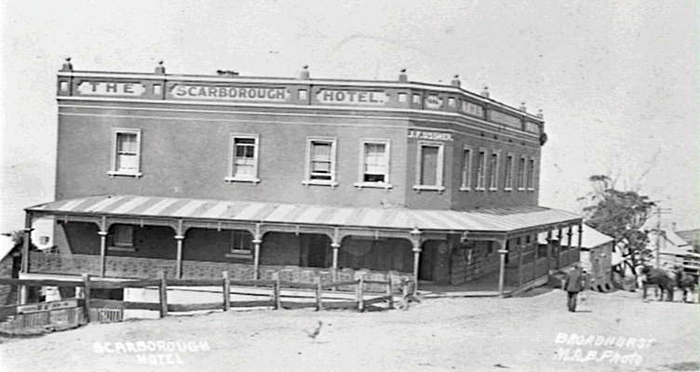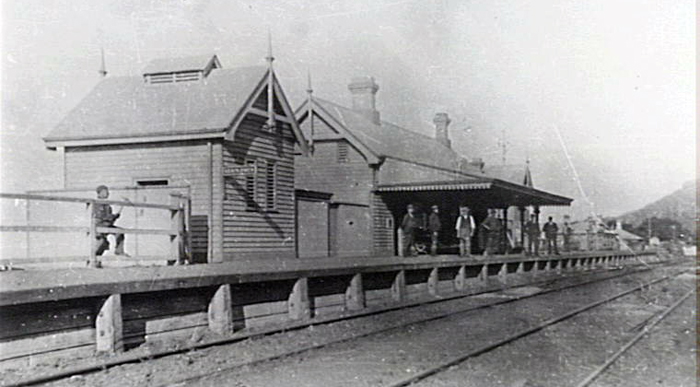Parish: Southend
County: Cumberland
Scarborough is in the north of the Wollongong Local Government Area, on the steep escarpment overlooking the ocean.
Local communities of Aboriginal people were the original inhabitants and Traditional Custodians of Illawarra Land. Their dialect is a variant of the Dharawal language.
Before European settlement, the Aboriginal people of the region lived in small family groups with complicated social structures and close associations with specific areas.
Suburb boundaries do not reflect the cultural boundaries of the local Aboriginal community.
Traditional Custodians today are descendants of the original inhabitants and have ongoing spiritual and cultural ties to the Land and waterways where their ancestors lived.
Scarborough was originally known as South Clifton.
A hotel opened in the area in 1887 and was named Scarborough Hotel.
The South Clifton railway station was renamed Scarborough in October 1903 and the use of the name South Clifton was discontinued.
There are two explanations for the origin of the name Scarborough. The first is that it was named after the seaside resort in Yorkshire, England. The second is that it was named after one of the convict transport vessels in the First Fleet. The name Scarborough means “Fort on the Rock”.
Land Grants
North of the town of Wollongong, the land available in the Illawarra consists of a narrow strip lying between the Illawarra escarpment and the ocean. This narrow strip gradually tapers to a point where the range dips to the sea at Clifton. The majority of this area was absorbed in grants north of the township of Wollongong made to R and C Campbell and John Buckland (Lindsay, 1994).
Walter McLaren
Mr McLaren was the first teacher at Clifton Public School (renamed Scarborough Public School in December 1915). He arrived in July 1878 after travelling by coach from Campbelltown to Bulli. He completed his journey to Clifton on foot. Mr McLaren began his classes in a shed rented from the Colliery. He had 17 pupils. Eventually a timber school with accommodation for 49 pupils was completed, together with a teacher’s residence consisting of two rooms and a kitchen (Barnetson, 1988).
In 1884 the School Inspector, Mr Murray, recommended that Mr McLaren be transferred and replaced by a married teacher. Mr Murray believed that the school residence was more suitable for a married person. Mr McLaren was very popular among the parents and residents who strongly objected to this proposed transfer. Mr McLaren was not transferred. He was married the following year (Barnetson, 1988).
Mr McLaren finally left the school in 1896. Over 400 people attended his farewell at the Clifton Public Hall. He received a number of gifts, including an ‘Illuminated Address’ illustrated with local scenes and designed by many prominent local citizens (Barnetson, 1988).
South Clifton Colliery
The South Clifton mine opened in 1891. In 1905 the output of the mine was 63,750 tons.
In 1906 it was reported that the South Clifton Coal Mining Co Ltd held about 2,000 acres of land. This land included the Bulli seam which had a height of 4 feet to 5 feet 6 inches. “The mine is worked from a shaft sunk 200 feet, the old method of pick and shovel being employed for the getting out of the coal. The miners are paid on a tonnage basis. The electric light is installed throughout the mine” (South Coast Times, 24 November 1906).
The coal was dispatched from the mine in Government railway traffic wagons for shipment at Darling Harbour or Port Kembla. The company also had 32 coke ovens on the property. The output of coke was 800 to 1,000 tons per month (South Coast Times, 24 November 1906).
Rail
Construction of a rail link between Sydney and Wollongong was approved in 1881. It was to be done in three sections: from Sydney to George’s River, from George’s River to Clifton / Coalcliff, and then from Clifton to Albion Park. The third section was completed and opened in 1887. A year later the second section was completed and stations built at Clifton, Bulli and Wollongong. The section between Waterfall and North Clifton was the most complicated of all. In the comparatively short distance of seven miles, there were seven tunnels to be constructed, one of them being almost a mile long (Illawarra Mercury 10 August 1900).
Road
In 1878 the road from Bulli to Stanwell Park was only a rough track. Once mining began in the area, a road became a necessity. In 1878 the Government allotted funds to build a road from Bulli through Clifton to Stanwell Park. Reports in the Illawarra Mercury show that rockfalls and landslips were a continual problem (Wollongong Advertiser, 15 June 1988, p.10).
Scarborough Hotel
Address: 383 Lawrence Hargrave Drive
Scarborough Hotel was built in 1886. It is two storey painted render with cornice and parapet in a Victorian Free Classical Style. The Hotel is still in good condition although the modern awning detracts from architectural quality and the ground floor tiles have been modified (City of Wollongong Heritage Study, 1991).
Alfred Broadhead, who built the hotel, retired as host in 1910. Patronage came from the miners at the South Clifton Colliery. During World War II the large sign, Scarborough Hotel, was compulsorily removed in the interests of security and the windows were blacked out (Illawarra Mercury 10 August 2000).

Image: Scarborough Hotel, image number P02376.
Scarborough Railway Station
The station opened as Clifton Station in 1887 and its name was changed to Scarborough in 1903. It is in good condition and retains architectural quality, although it has been modified from original design materials. The building is brick with corrugated steel roof and corrugated iron awning brackets. This building is one of the surviving small stations on the Illawarra Line and is associated with the opening of the line (City of Wollongong Heritage Study, 1991).

Image: Scarborough Railway Station ca. 1915, image number P09298.
Urban development has greatly affected the lower escarpment slopes through the removal of natural flora and the loss of soil and rock. The escarpment is a very striking feature of the environment. The scarp descends to Bulli through rainforests of brushwoods, tall ferns, conifer like brown pine, cabbage trees, sassafras and understorey vegetation which include rough tree ferns. The land slope is predominately steep to mountainous.
Fauna expected to be found in this area include possums, macropods and reptiles. Several hundred species of bird exist in this region in suitable habitat provided by vegetation on the Escarpment (Illawarra Escarpment Environment Inquiry, 1973).
There are two main areas of rock fall and these are along the coastline in the Coalcliff / Scarborough area and along the scarp. The former area is subject to frequent small rock falls due to the rate of erosion of the toe of the cliffs by wave and salt spray action.
At present considerable beach erosion occurs during storms. The Scarborough platform and the adjacent embayment produce food resources for a variety of seabirds, including the Sooty Oystercatcher and the Great Cormorant (Environmental Science Ecology Studies, 1992).
Effective weed management is an ongoing concern of the Illawarra Escarpment. The rainforest of the Escarpment is presently penetrated by extensive areas of Lantana Camara which poses a fire risk to the rainforest (Environmental Science Studies in Ecology 1987).
| Date | Event |
|---|---|
| 1886 | Scarborough Hotel built |
| 1891 | South Clifton (Scarborough) mine opened |
| 1903 | The South Clifton railway station was renamed Scarborough |
| 1911 | Scarborough Court House opened by A Elliott, S.M. |
| 1912 | Bazaar raises funds for Illawarra Cottage Hospital to be built midway between Coledale and Scarborough |
| 1913 | Foundation dug for a new 'Central Public School' for Clifton and Scarborough |
| 1914 | Scarborough surf club formed |
| 1914 | New public school opened at Scarborough by the Minister for Education to replace Clifton School |
| 1914 | Electric light switched on from Austinmer to Coledale, Scarborough and Clifton by Mrs Davidson |
| 1915 | Rifle Club formed |
| 1915 | Clifton Public School became known as Scarborough Public School |
| 1920 | South Clifton (Scarborough) mine closed |
| 1922 | New St Paul's Scarborough Church of England opened |
| 1926 | Scarborough swimming baths built below the Presbyterian church by volunteer labour |
| 1960 | Scarborough - Wombarra Bowling Club opened on 8 May |
Bayley William A., Black Diamonds: history of the Bulli District NSW, Austrail Publications, Bulli, 1975.
Barnetson, Diane. Scarborough Public School: 1878-1988, Scarborough, 1988.
Wollongong City Council, McDonald McPhee Pty Ltd, City of Wollongong Heritage Study, Wollongong, 1991.
Illawarra Escarpment Environment Inquiry: background report. Illawarra Escarpment Environment Enquiry, 1973.
Illawarra Mercury, Wollongong, NSW: Illawarra Newspapers Holdings, 1856-
Jervis, James. Illawarra: a century of history 1788-1888, Royal Australian Historical Society, Sydney 1942.
Lindsay, Benjamin, Organ, Michael & Doyle, Peter, Early land settlement in Illawarra (1804-1861), Woonona: Illawarra Historical Publications, 1994.
Local Studies Cutting File.
Odell L. et al., Environmental science ecology studies, Wollongong: Dept Biological Sciences, University of Wollongong, 1992.
Place names of the Wollongong Region, Wollongong: Wollongong City Council, 2008.
South Coast Times [microform], Milsons Point, NSW: W. & F. Pascoe, [n.d.].
Telford E. et al., Environment science studies in ecology, Wollongong: Dept of Biology, University of Wollongong, 1987.
Wollongong Advertiser, Wollongong, NSW: Illawarra Newspapers Holdings, 1982.
Top image: Main Road, Scarborough. See image details on our catalogue
